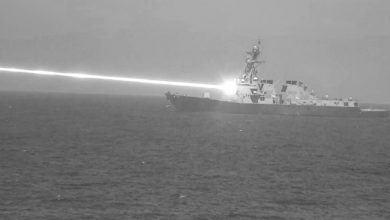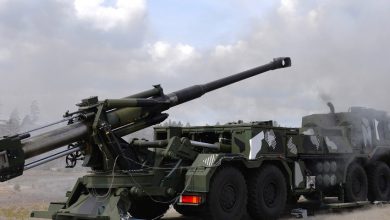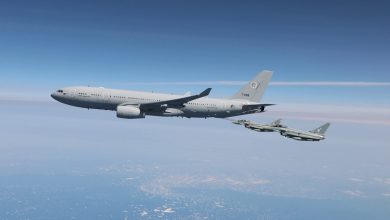Low Earth orbit: Disruptive military technologies

The ability to communicate has always shaped the way militaries fight, with the flow of information often dictating the pace, momentum and accuracy of action and distance, weather and terrain doing their best to constrain it. Chris Moore, vice president Defence & Security at OneWeb, explains how the rise of low Earth orbit (LEO) satellites can disrupt how militaries fight.
Smoke signals, messengers on horseback, flags on ships and hills, telegraph lines and more recently radio and satellite communications have evolved over time to compress the time to deliver information in increasing volume and distance. This in turn has helped synchronise the mass, scale and diversity of force elements to deliver enhanced lethality.
The second half of the 20th Century saw the rise of satellite communications (SATCOM) which enabled higher-capacity communications beyond line-of-sight making it possible for deployed commanders to receive information thousands of miles away.
Until recently, the majority of SATCOM has been the preserve of geo-synchronous (GEO) satellite in orbits of 36,000km from the Earth’s surface. The big advantage of GEO is that ground satellite terminal technology was relatively simple because it points at a narrow, almost stationary ‘box’ in the sky to maintain lock with the satellite.
GEOs’ distance from Earth has also helped mitigate the threat from Direct Ascent weapons from the Earth, but that threat has evolved and just possessing a few hardened GEO satellites is not necessarily the assurance countries once needed.
The disadvantages with GEO include relatively higher latency communication paths, which induces lag into voice and data connectivity, particularly for real-time collaboration applications and time-sensitive machine-to-machine functions, the latter of which will become key ground for semi and autonomous platforms.
GEO satellites also have fixed views of the earth and tend to be in an equatorial plane which means they have limitations in their coverage, particularly for High North and South operations and at the edge of beams. The fixed positioning also means that satellite ground terminal look angles can also be challenging – not just at High North and South locations – but sometimes with obstructions blocking the line of sight with the satellite; for example a mountain, high-rise building or even ‘wooding’ on a ship. The lack of relative orbital velocity with the Earth also makes them relatively easy to target through jamming – although it should be noted that some military satellites do have counter-jamming technologies.
In recent years medium Earth orbit (MEO) satellites have entered the fray, and whilst they do have some similar constraints, they do also lessen the negative aspects of GEO and can deliver high-capacity beams to meet a range of emerging requirements. However, the real game-changer is the commercially viable production of LEO SATCOM at scale.
The advantages of LEO have been known for some time, but technology and scale constraints have made them cost-prohibitive to build. However, plummeting launch costs, state-of-the-art satellite production lines, inspired by car manufacturing and the convergence of advanced telecommunication technology, has created the condition for the rise of the LEO SATCOM constellations.
Gaining tactical advantage
SATCOM technology has undeniably changed and enhanced the way conflicts are fought. LEO space-based SATCOM allows military forces to access and share information across the battlefield in real-time, giving them unprecedented levels of information advantage against their enemies.
Compared to traditional SATCOM solutions at higher altitude geostationary orbits, LEO-enabled SATCOM provides end users with truly global coverage, seamless mobility (no edge of beam transition issues), in addition to increased bandwidth capacity at lower latencies.
High capacity and low latency, direct to the tactical edge without the need to traverse a range of disparate bearers and conventional connectivity, means data sharing, cloud services, augmented reality and real-time video are instantly accessible, enabling armed forces to conduct operations with even greater precision and efficiency.
As witnessed in the ongoing war in Ukraine, pioneering pop-up connectivity solutions, via a LEO network capability, enabled critical communications to be passed more efficiently and with less risk, resulting, at least initially, in higher tempo operations driven by the increased mobility of the Ukrainian forces.
However, large-scale militaries traditionally favour centralised structures because they require co-ordination and control over numerous units, resources, and complex operations. This allows for standardisation, synchronisation, and effective execution of overarching strategies. The trade-off is that centralisation can impede agility and responsiveness, as decision-making processes can be slow and less adaptable in comparison to decentralised approaches, which are better suited to rapidly changing circumstances.
To address this challenge, modern militaries must strike the right balance between centralisation and decentralisation, optimising organisational structures to the problems they face. For example, a commander may choose to establish decentralised command structures at lower levels or deploy specialised units with greater autonomy for particular problem sets.
A hybrid approach may seek to combine the advantages of centralised control with the benefits of decentralised decision-making, enabling both efficiency and agility in military operations. This allows for highly manoeuvrable forces with compressed decision cycles – or OODA[1] for the Colonel John Boyd purists. The advancements in communication technologies and network-centric warfare has increased the potential for adaptable organisational models for modern militaries to apply, which perhaps underpins some of the thinking emerging for “multi-domain operations”.
Resilient, ubiquitous communications have also helped populations to stay connected and gain advantage in the so-called ‘information warfare’; again this is evident in the current conflict in Ukraine, where the Ukrainian’s have waged a hugely successful counter-narrative against their Russian adversaries, once thought of as modern-day pioneers of this dimension of warfare. Communicating to the world via social media channels, television, radio and the press, the Ukrainian’s have highlighted the atrocities, brutality and sometimes incompetence of the Russian military, and used it to help build powerful, international support against Putin’s war machine. And for the civilian population in Ukraine having reinforced internet connectivity has meant they have been able to stay connected when traditional terrestrial connectivity has been taken down and importantly reassured by Zelenskyy’s stoicism.
Robust and resilient communications have changed the face of the contemporary conflict and have enabled the pen – or in this case keyboard – to become mightier than the sword.
Delivering truly resilient connectivity
With the use of small, mobile and robust multi-domain user terminals, easily deployed as an integrated eco-system on the land, in the air and at sea, LEO SATCOM has effectively unlocked the military constraints on accessing and sharing huge quantities of information in real-time, wherever you are on the planet – the North Pole, the summit of Everest, a vast ocean or in an aircraft.
Using small and lightweight user terminals on the ground or vessel, military personnel can receive up-to-date information about the ground, enemy and friendly force movements by tapping into a secure military network when other means of connectivity are disabled or disrupted. This information can then be seamlessly relayed across the front line or back to headquarters thousands of miles away, allowing commanders to make informed decisions that can turn the tide of a conflict.
Reliable and always-on connectivity is also paramount to the welfare and retention of troops. Soldiers, sailors, and aviators who have grown up in a connected world, away from home and used to on-tap internet, must have the opportunity to connect anytime, anywhere unless there are compelling operational reasons not to.
This allows them to retain links to family, friends and society, even during the most difficult times – something that is essential to the retention of their services and overall mental and physical wellbeing.
However, the advancement of the LEO SATCOM does not make MEO and GEO redundant – far from it. Each orbit has its own strengths and weakness, the trick is to design a coherent, multi-orbit architecture that converges with terrestrial networks to deliver truly resilient connectivity that routes data in the smartest possible way.
The real gamechanger will come when militaries combine the right balance of edge/cloud computing, with mobility and the right balance of multi-orbit connectivity, which will create the conditions for the 21st Century version of Blitzkreig.

OneWeb is at the forefront of the LEO revolution, keeping populations connected, particularly in remote locations or when traditional communications networks are disrupted. Having successfully completed its Generation One satellite launches, OneWeb offers a live service today which will expand to global coverage by the end of 2023. Alongside our industry partners, the company will ultimately deliver a robust ecosystem of solutions optimised for multi-domain use-cases.





